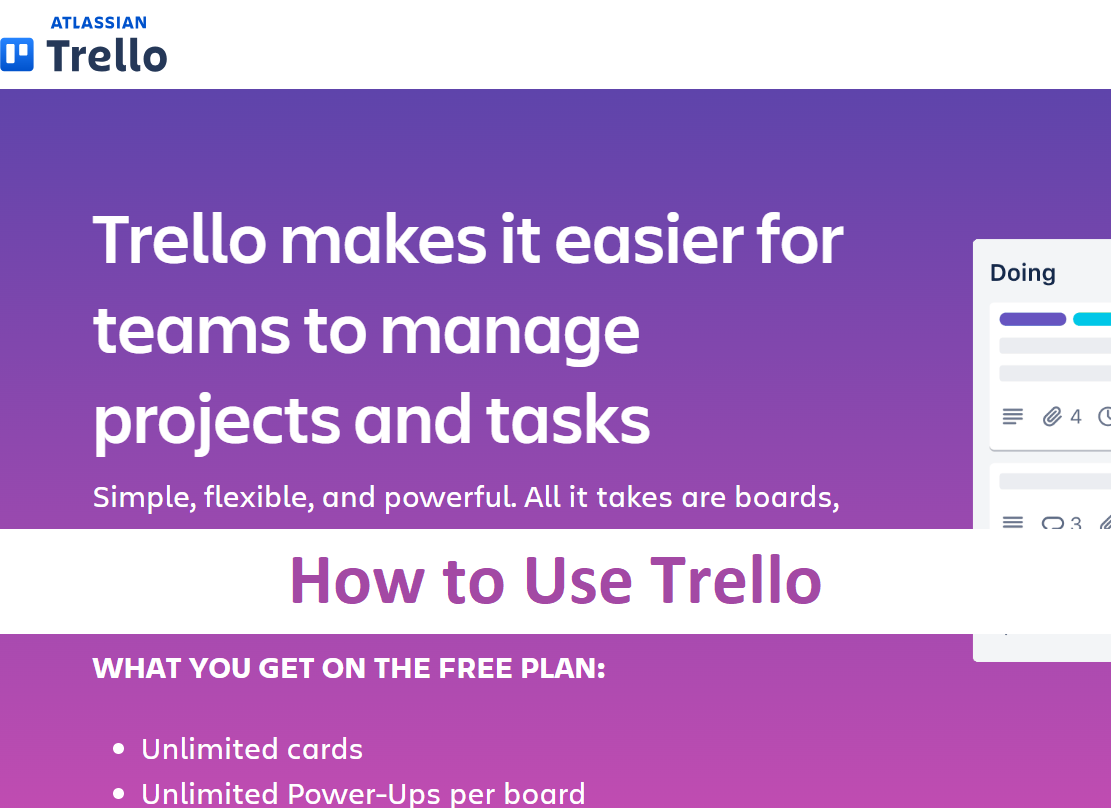
Trello is a powerful and flexible tool for task management, enabling individuals and teams to organize tasks, projects, and workflows effectively. Its user-friendly interface, built around the concept of boards, lists, and cards, makes it an ideal choice for managing anything from simple to complex projects. This guide will walk you through the steps to maximize Trello’s potential for task management.
How to Use Trello
1. Getting Started with Trello

Creating an Account
To get started with Trello, visit Trello’s website and sign up for an account. You can sign up using an email address, Google account, or Microsoft account.
Creating Your First Board
Once logged in, you’ll see the Trello dashboard. Start by creating your first board:
- Click on the “Create new board” button.
- Name your board according to the project or task you want to manage.
- Choose a background color or image that suits the project.
- Click “Create Board” to get started.
2. Understanding the Trello Structure

Trello’s organization revolves around three main components: Boards, Lists, and Cards.
Boards
A board represents a project or a high-level task. For example, you might have boards for different projects at work, personal goals, or event planning.
Lists
Lists are columns within your board that help you organize tasks into different stages. A common method is to have lists like “To Do,” “In Progress,” and “Done.” However, you can customize these lists to suit your workflow.
Cards
Cards represent individual tasks or items within a list. For example, under a “To Do” list, you might have cards for specific tasks like “Write report” or “Call client.”
3. Managing Tasks with Trello

Adding and Customizing Cards
To create a card:
- Click “Add a card” under the list where you want it to appear.
- Name the card according to the task.
- Click “Add Card.”
You can then click on the card to add more details:
- Description: Provide detailed information about the task.
- Due Date: Set a deadline to keep track of time-sensitive tasks.
- Labels: Color-code your tasks for better visual organization.
- Attachments: Upload files or attach links relevant to the task.
- Checklists: Break down tasks into subtasks with checklists.
- Comments: Collaborate with team members by adding comments.
Moving Cards Between Lists
As tasks progress, you can easily move cards between lists. For example, when you start working on a task, drag the card from “To Do” to “In Progress.” Once completed, move it to “Done.”
4. Collaborating with Teams on Trello

Inviting Team Members
You can invite team members to collaborate on a board:
- Click on “Invite” at the top of the board.
- Enter the email addresses of your team members.
- Assign them appropriate permissions (Admin, Normal, or Observer).
Assigning Tasks
Assign tasks to team members by:
- Clicking on the card.
- Selecting “Members.”
- Clicking on the team member’s name to assign the task.
Using Comments and Mentions
Keep communication clear and transparent by using the comment feature on cards. You can mention team members by typing “@” followed by their username.
5. Advanced Trello Features

Power-Ups
Trello offers “Power-Ups” to extend the functionality of your boards. These integrations allow you to connect Trello with other tools like Google Drive, Slack, and Jira. To enable a Power-Up:
- Click on “Power-Ups” in the board menu.
- Search for the integration you need.
- Click “Add” to enable it.
Automation with Butler
Butler is Trello’s automation tool that helps automate repetitive tasks. You can create rules, buttons, and scheduled commands to save time. For example, you can set up a rule that automatically moves a card to “Done” when all checklist items are completed.
Calendar View
Use the calendar view to see all your tasks with due dates on a calendar. Enable the Calendar Power-Up to switch to this view and plan your tasks accordingly.
6. Tips for Effective Task Management with Trello

Keep It Simple
Start with a basic setup and add complexity only when necessary. Too many lists and cards can make your board overwhelming.
Regularly Review and Update
Review your Trello board regularly to ensure tasks are moving forward. Archive cards that are no longer relevant to keep the board clean.
Use Labels Wisely
Color-coded labels can help you quickly identify the type of task, its priority, or the department responsible for it. Create a labeling system that makes sense for your workflow.
Make Use of Templates
Trello allows you to create board templates, which can be particularly useful for recurring projects. Create a template once, and use it as a starting point for similar projects.
Conclusion
Trello is a versatile tool for task management, suitable for both individuals and teams. By understanding and utilizing its core features—boards, lists, and cards—you can create a streamlined workflow that enhances productivity. With the additional power of Trello’s advanced features like Power-Ups and Butler automation, you can further customize your task management process to fit your specific needs.
By following this guide, you’ll be well on your way to mastering Trello for efficient and effective task management.




